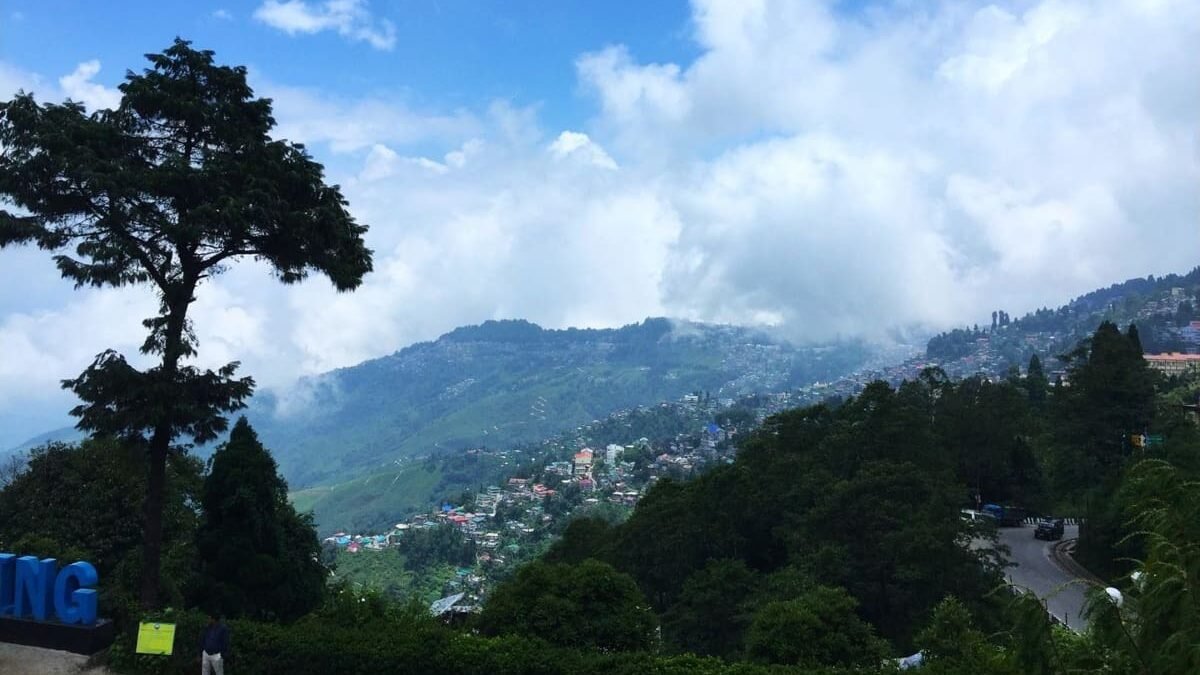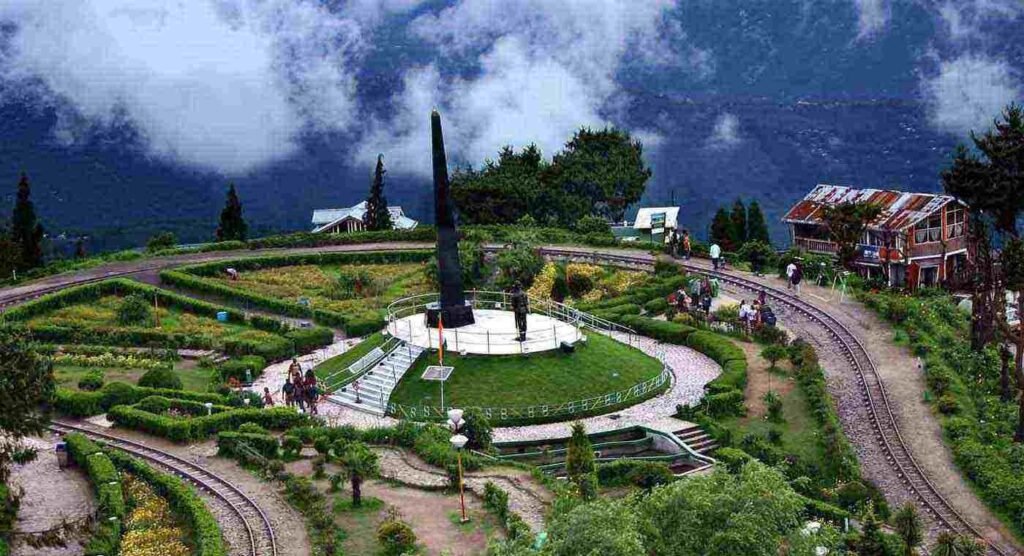Darjeeling, often referred to as the “Queen of the Hills”, stands as one of India’s most captivating hill stations, nestled in the lap of the eastern Himalayas. Promising breathtaking views, a cool climate, lush tea estates, and a unique blend of British colonial and Himalayan cultures, the region lures travellers from across the globe.
Perched at an altitude of about 2,050 meters, Darjeeling flourished as a summer retreat during the British era and is now celebrated for its tea, scenic railway, and vibrant local heritage. The district’s landscape is a dramatic portrait of snow-capped peaks, rolling hills blanketed with emerald tea gardens, and colonial architecture that echoes a storied past.
Getting There: Routes and Travel Information
Darjeeling is accessible through multiple routes:
- By Air: The nearest airport is Bagdogra (about 70 km away). From Bagdogra, taxis and buses ply daily to Darjeeling.
- By Rail: The closest major railhead is New Jalpaiguri (NJP). From NJP, travellers experience the iconic Toy Train or take a road journey.
- By Road: Well-connected by national highways, regular buses, and shared jeeps ply from Siliguri and nearby towns. The approach winds through scenic valleys and lush forests, making the trip memorable.
Location and Climate
Darjeeling district lies in the northern part of West Bengal, bordered by Sikkim and Nepal. Its average elevation ensures cool, pleasant weather throughout the year. The best time to visit is from March to May and October to December, when the skies are clear and the mountain vistas are at their most breathtaking.
Key Details:
Notes on Costs and Tips:
- Markets, Mall Road, and public sites often have no entry fee, but personal expenses (cafes, shopping) are extra.
- Costs are approximate and reflect solo travellers or single adult prices; group/shared cab or tour rates are often lower per person.
- Most sites are accessible via local sightseeing cabs. Day sightseeing tour rates range ₹3,000–₹8,600 for a full cab (up to 8 people).
- Activities such as the Darjeeling Toy Train and the Sandakphu trek require pre-booking, especially during peak seasons.
Rich History and Timeless Legacy
Darjeeling’s journey began in the mid-19th century under British rule. The region quickly transformed into a renowned hill station for the British elite. Missionary schools, such as Loreto Convent (1847) and St. Paul’s (1864), marked their educational significance, while tea plantations kick-started an economic revolution. The Darjeeling Himalayan Railway, a marvel recognised as a UNESCO World Heritage Site, connected the hills and valleys, sealing Darjeeling’s reputation as a world-class retreat.
Culture: A Melting Pot of Heritage
The people of Darjeeling are intimately tied to Gorkha, Tibetan, Lepcha, and Bengali traditions, resulting in a dynamic cultural environment. Artistic handicrafts, age-old monasteries, the rhythm of Himalayan folk music, and colourful festivals showcase the district’s rich diversity. Tea ceremonies and local fairs further animate Darjeeling’s lively spirit.
Tourism Revenue and Economic Impact
Tourism is a major economic driver for Darjeeling, accounting for a significant portion of the local economy. As of 2023-2024, tourism in Darjeeling generated annual revenues crossing Rs 450 crore. Tea and experiences, such as the Toy Train ride, add substantial value. The influx of travellers, especially during peak seasons, stimulates local hospitality, transportation, and artisan markets, enhancing livelihoods across the district.
Top 10 Places to Visit in Darjeeling District
Here’s a handpicked list, with details for each location:

Detailed Descriptions
Tiger Hill
Renowned for its breathtaking sunrise, Tiger Hill offers clear vistas of Kanchenjunga and Mount Everest on cloudless days. Located 14 km from Darjeeling town, visitors usually start before dawn to catch the changing hues of the snow-clad mountains. It’s the most visited spot in Darjeeling, with footfalls peaking during tourist seasons.
Darjeeling Himalayan Railway (Toy Train)
A UNESCO World Heritage marvel, the Toy Train transports visitors from New Jalpaiguri to Darjeeling, winding its way through lush hills, quaint stations, and tunnels. The slow-paced journey promises nostalgia and phenomenal valley views, especially at Ghum, the highest railway station in India.
Batasia Loop & War Memorial
This exquisite spiral rail track, with well-tended gardens at its centre, is both an engineering feat and a tranquil retreat. The War Memorial here commemorates the brave Gorkha soldiers, while the surrounding gardens offer sweeping vistas of the surrounding hills and valleys.
Padmaja Naidu Himalayan Zoological Park
Famed as India’s highest-altitude zoo, this park treasures rare and endangered Himalayan species, including the adorable Red Panda, snow leopard, and Tibetan wolf. The zoo operates breeding programs and draws families and wildlife enthusiasts for its educational insights.
Peace Pagoda
This iconic Buddhist stupa sits atop Jalapahar Hill, radiating tranquillity with its white façade and golden Buddha statues. Open to all, it’s designed for silent reflection, meditation, and panoramic photo opportunities over Darjeeling town.
Happy Valley Tea Estate
With a history dating back to 1854, the Happy Valley Tea Estate invites tea aficionados to experience immersive tours and tastings. Learn about the region’s world-famous tea production while strolling past vibrant green slopes and vintage colonial buildings.
Ghoom Monastery
Ghoom (or Ghum) Monastery, built in 1850, is the region’s oldest Tibetan Buddhist monastery. Home to an awe-inspiring 15-ft Maitreya Buddha statue and ancient manuscripts, it’s a haven of peace and spirituality amid the hills.
Himalayan Mountaineering Institute
Founded to honour Tenzing Norgay’s Everest ascent, this museum and training centre inspires adventure seekers. Explore historic gear, mountaineering artefacts, and courses, all set within manicured gardens beside the zoo.
Sandakphu & Singalila National Park
For trekkers, Sandakphu, West Bengal’s highest point, offers an unparalleled vantage over four of the world’s five highest peaks. The surrounding Singalila National Park bursts with rhododendron blossoms, rare wildlife, and breathtaking trekking trails.
Chowrasta Mall Road
The beating heart of Darjeeling, Chowrasta (also known as Mall Road), is a pedestrian-friendly area rich in colonial-era charm. Lined with cosy cafes, curio shops, and lively street vendors, it’s a perfect haunt for souvenir shopping and people-watching.
Bonus Attractions
- St. Andrew’s Church: A fine example of colonial Gothic architecture and spiritual solace.
- Ava Art Gallery, Bhutia Busty Monastery, and Observatory Hill: Lesser-visited, yet culturally and historically significant.
- Darjeeling Ropeway: Get aerial views of tea gardens and valleys from the cable car; perfect for families.
FAQs About Darjeeling
What is the best time to visit Darjeeling?
March to May and October to December offer clear skies, cool weather, and optimal views of the Himalayas.
How do I reach Darjeeling?
Arrive via Bagdogra airport or New Jalpaiguri railway station, then enjoy a scenic drive or Toy Train ride to the hill station.
What are Darjeeling’s local foods to try?
Don’t miss momos, thukpa, Darjeeling tea, churpee, sel roti, and local bakery delights.
Is Darjeeling family-friendly?
Absolutely! With zoos, parks, tea gardens, and the Toy Train, there are plentiful attractions for all age groups.
How is the tourism economy in Darjeeling?
Tourism is the district’s lifeblood, generating over Rs 450 crore annually and supporting thousands of local livelihoods.
Are there offbeat places near Darjeeling?
Yes! Consider exploring Tinchuley, Lolegaon, Kurseong, and Lepchajagat for serene, less-crowded escapes.
Travel Tips and Essential Information
- Permits: No special permits are required for Indian tourists; however, foreigners visiting border areas, such as Sandakphu, must register.
- Safety: Darjeeling is generally safe, but it is always advisable to use licensed taxis and avoid deserted trails late at night.
- Local Crafts: Shop for handwoven textiles, Tibetan carpets, traditional jewellery, and world-renowned Darjeeling tea.
- Sustainability: Respect local customs, avoid littering, and choose eco-friendly accommodations to preserve Darjeeling’s pristine beauty.
Final Thoughts: Darjeeling’s Lasting Allure
With its dramatic Himalayan visage, storied past, vibrant festivals, and unmatched tea, the Darjeeling district continues to enchant travellers, year after year. Whether cherished for sunrise panoramas, historical relics, or trekking adventures, its magic is timeless, inviting both old friends and new visitors to discover its secrets.
Recent News :
Darjeeling has seen unprecedented tourist arrivals this year, with key sites like Tiger Hill, the Toy Train, Peace Pagoda, and Sandakphu reporting record crowds. Local authorities attribute the boom to improved infrastructure, effective destination marketing, and a renewed global interest in Himalayan ecotourism. As more travellers embrace the call of the hills, Darjeeling’s charm is shining brighter than ever, assuring its place on every traveller’s bucket list.
